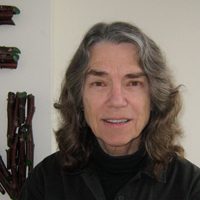

Gyöngy Laky’s work is visually diverse, structurally intriguing and tactilely rich. Whether in her grids, vessels, language related sculptures or abstracted architectural forms her hand-constructed work cues a combined sensory and mental experience. She explores the possibilities of form, arrangement, dimensionality, material, texture and pattern. She is fundamentally concerned with learning, remembering, thinking and understanding through the relationship between what is tangible and tactile and what is metaphorical.
Laky works where the physical intersects with word, thought and imagination. With simple text, common signs or familiar objects she probes how experiencing these in visual, physical form might alter, extend and/or enhance a viewer’s response. By what is recognized and what is suggested she seeks the mental connections one might not otherwise make. She cunningly combines the verbal with the visceral.
Educated as she was among artists and architects at the University of California, Berkeley, Laky borrows freely from various methods and materials associated with architecture to adroitly construct sculptural wall works and freestanding forms while pursuing an aesthetic, intellectual and social enterprise. Through her extensive travels she developed an interest in simple, vernacular, hand built structures such as fences, basketry, grills, lattices, trellises and scaffolding as is evident in her approach to structure.
Using screws, nails, dowels and wire, she connects natural branches or commercial wood (even charcoal, plastic soldiers, or, occasionally, recycled post-consumer items) in intersecting arrays. Some results are dense entanglements of intertwining lines and some are sparse, open-work, air-filled, linear arrangements. The incongruities of nails or screws protruding from branches hints at edgy relationships and the flux of human interaction with nature.
Her characteristic sharp, slant cuts heighten the edginess – sometimes focusing on the linear element and sometimes on the densely structured object composed of many intersecting lines. Though these works gesture toward crown of thorns imagery, they are surprisingly elegant.
Laky’s approach is also invigorated by her attraction to puzzles and her fascination with human ingenuity about making things by hand. The works, are often playful and quirky and some an incongruous assemblage of items and ideas. Laky likes to tease the brain – to promote or even to provoke or cajole, a critical dialogue with the viewer.
Her art has been described as “elegant and ornery,” “crude and tidy,” “playful and suggesting menace,” “perfectly formed masses of chaos” that attract and, yet, suggest the possibility of trouble “making dissonance work for her.”
“I like things which are slightly irritating or uncomfortable or off balance or even, sometimes, grotesque.” Laky asserts when describing her work. “I like it when we are puzzled or do not have answers. At such times, I believe something unexpected could take place providing new insights and understandings.”
Disrupting and distorting the regularity of orderly grid arrangements Laky calls up a related duality. For example, in gracefully manipulated undulations of Manzanita branches there is a trace of its deadly potential. A ubiquitous evergreen tree/bush, Manzanita, with its exquisite deep purplish-brown-red bark, grows weed-like throughout the West Coast. When wildfires burn this extremely hard wood, it readily bursts into flame and burns for long periods with extreme heat. Frequently referring to herself as an environmentalist, Laky builds many of her works with a variety of tree prunings – discarded branches gathered from orchards, hillsides, street trees and gardens.
Themes in Laky’s recent work, however, cross a variety of subjects and social issues. Often it is presented through the form of words, letters or symbols exploring letters and symbols as sculptural forms in addition to what they might convey. Laky undertakes to make a letter function like a sentence and to make a symbol, single word, sign or object function like a narrative. Her deceptively simple construction methods belie a complexity of meaning.
Her interest in shapes and forms of letters might have been a path to learning language as a child. Born in Budapest, Laky’s early years exposed her to numerous languages. She considers learning new words and new languages play. She spoke Hungarian and German at home (her mother, a painter, also spoke Polish and French and her father, English). At age 5 she arrived in the U.S. and quickly picked up English (fluency in French came later in High School). She has pursued some studies of Italian and Spanish and through her travels she has been exposed to and has played with others including Hindi, Catalan, Yiddish, Russian, Greek and Dutch.
As of 2005, Gyöngy Laky is Professor Emeritus at the University of California, Davis (design and art). Her work is in museum collections in Europe and the United States, including the San Francisco Museum of Modern Art and the Oakland Museum of California.
Image courtesy of S. Tejamo
Website
http://www.gyongylaky.com
